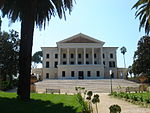Mondo TV
Companies listed on the Borsa ItalianaFilm distributors of ItalyFilm production companies of ItalyHarv and Sfn no-target errorsItalian animation studios ... and 5 more
Italian companies established in 1985Mass media companies of ItalyMass media in RomePublishing companies established in 1985Publishing companies of Italy
Mondo TV is an Italian production and television distribution company. Founded by Orlando Corradi in 1985 and based in Rome, Mondo TV is a public company, quoted on the STAR segment of the Italian main stock exchange, Borsa Italiana. It distributes and produces, on its own or in co-production with international networks, cartoon series and feature films for television and theatrical release. Mondo TV also operates in other related sectors such as music and audiovisual distribution, exploitation, media, publishing and merchandising, and is one of the few branches of Italian audiovisual production companies or groups active in markets outside Italy.
Excerpt from the Wikipedia article Mondo TV (License: CC BY-SA 3.0, Authors).Mondo TV
Via Dora, Rome Trieste
Geographical coordinates (GPS) Address Nearby Places Show on map
Geographical coordinates (GPS)
| Latitude | Longitude |
|---|---|
| N 41.918383 ° | E 12.502867 ° |
Address
Quartiere Coppedè
Via Dora
00198 Rome, Trieste
Lazio, Italy
Open on Google Maps








